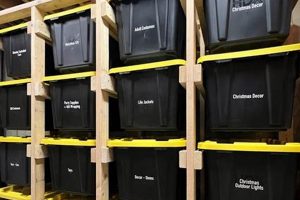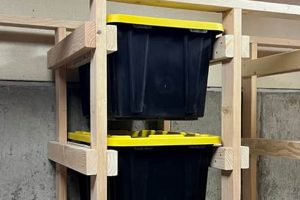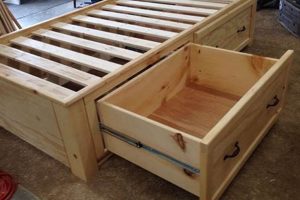Organization of costumes and related accessories is essential in households with children who engage in imaginative play. The practice typically involves creating designated spaces or containers for garments, shoes, hats, and other props that facilitate role-playing activities. For example, a repurposed wardrobe, a set of labeled bins, or a custom-built shelving unit can serve this purpose.
The advantages of dedicated spaces for play-related clothing items include promoting tidiness, enhancing the longevity of the items by minimizing wear and tear, and fostering independence in children by enabling them to access and manage their belongings. Historically, trunks and hope chests served as initial storage solutions, evolving into more specialized systems as child-centric design became prevalent.
The following sections will explore various methods for constructing cost-effective and personalized solutions for optimizing the storage and accessibility of dress-up clothing and accessories.
Strategies for Optimal Costume Arrangement
Effective management of play-related clothing and accessories necessitates strategic planning and implementation. The following tips offer guidance for optimizing the organization and accessibility of these items.
Tip 1: Vertical Organization. Utilize vertical space through the installation of wall-mounted shelving or tiered hanging systems. This approach maximizes storage capacity in limited areas and facilitates easy visibility of available items.
Tip 2: Transparent Containers. Employ clear bins or containers to store accessories such as hats, gloves, and jewelry. The transparent nature of these containers allows for quick identification of contents without the need for extensive searching.
Tip 3: Categorization and Labeling. Establish a clear system of categorization for clothing and accessories. Label containers and shelves according to item type (e.g., “Hats,” “Shoes,” “Dresses”). This promotes order and simplifies the retrieval process.
Tip 4: Repurposed Furniture. Consider repurposing existing furniture items such as bookshelves, dressers, or wardrobes. These items can be adapted to suit storage needs and provide a cost-effective solution.
Tip 5: Rotation of Items. Periodically review and rotate items in storage. Remove outgrown or infrequently used items to create additional space and maintain a streamlined collection.
Tip 6: Child-Friendly Accessibility. Ensure that storage solutions are accessible to children. Lower shelves and easily reachable hanging rods promote independence and encourage children to engage in self-directed play.
Tip 7: Consistent Maintenance. Regularly inspect storage areas to maintain order and address any issues such as overcrowding or damage. This proactive approach prevents the accumulation of clutter and ensures the longevity of items.
By implementing these strategies, households can effectively manage costumes and related accessories, fostering a more organized and accessible environment for imaginative play.
The concluding section will provide a summary of key considerations and potential pitfalls to avoid when implementing storage solutions.
1. Space Optimization
In the context of costume and accessory management, effective space utilization is paramount. The efficient use of available area contributes directly to the organization and accessibility of these items, mitigating clutter and enhancing the play environment. This requires careful consideration of the physical dimensions of the storage area and the types and quantities of items to be accommodated.
- Vertical Expansion
Maximizing vertical space involves employing shelving units, hanging rods, or tiered organizers. This approach is particularly beneficial in areas with limited floor space. For instance, a wall-mounted shelving unit can house folded costumes, while a multi-tiered hanger can accommodate multiple garments without occupying significant horizontal space. This strategy effectively expands storage capacity without encroaching upon the usable area of a room.
- Repurposed Furniture Adaptation
Utilizing existing furniture items, such as bookshelves or dressers, presents a cost-effective method of space optimization. A bookshelf can be modified to include hanging rods for dresses, while a dresser can be subdivided with drawer organizers for smaller accessories. Adapting existing furniture reduces the need for new purchases and provides a customized storage solution tailored to specific needs and available space.
- Corner and Nook Utilization
Corners and other underutilized areas can be transformed into functional storage zones. Corner shelves or custom-built units can maximize the storage potential of these spaces. For example, a corner shelving unit can house a collection of hats, while a small nook can be converted into a dedicated dressing area. The strategic use of these spaces prevents them from becoming sources of clutter and contributes to a more organized overall environment.
- Collapsible and Foldable Storage Options
Foldable storage bins, collapsible hampers, and other portable options provide flexible storage solutions that can be easily adjusted as needed. These items can be deployed when additional storage is required and stowed away when not in use. This adaptability is particularly useful in households with dynamic storage requirements and limited permanent storage space.
These space optimization strategies, when applied thoughtfully, ensure that costuming and accessory storage becomes an organized, efficient, and accessible aspect of the household environment. The integration of vertical solutions, repurposed items, corner utilization, and flexible storage options contribute to an effective management system, regardless of available space.
2. Budgetary Constraints
The implementation of dress-up storage solutions is often significantly influenced by budgetary limitations. Financial restrictions frequently dictate the materials selected, the complexity of the designs employed, and the overall scale of the project. The direct correlation between available funds and the feasibility of constructing elaborate, commercially produced storage systems necessitates a focus on cost-effective, resource-efficient approaches. A constrained budget can lead to increased reliance on repurposed materials and simplified construction techniques. This necessitates ingenuity and the strategic application of available resources. For example, rather than purchasing new shelving units, individuals may opt to refurbish existing furniture or construct shelving from reclaimed wood, thereby minimizing expenses. The effects of these choices are seen in the reduced material cost, greater sustainability, and the potential for individualized design that is unavailable at a retail level.
The importance of budgetary considerations within the context of constructing play-related storage lies in the opportunity for creative problem-solving. Individuals must prioritize their needs, assess available resources, and adapt their plans accordingly. Examples include utilizing discarded cardboard boxes for temporary storage, converting old clothing racks into costume display units, and employing simple, easily sourced materials like PVC pipes to create hanging systems. Practical significance arises from the accessibility such a financial plan can provide for a wider audience. Families who might otherwise forgo organized spaces due to cost restrictions can leverage skills and resourcefulness to achieve an outcome that is tailored to their needs and circumstances.
In summary, budgetary restrictions represent both a challenge and an opportunity within the realm of costuming storage. While financial constraints may limit the scope of a project, they simultaneously encourage innovation and promote sustainable practices. The understanding of this connection allows for the development of creative, affordable solutions that are accessible to a broader range of individuals and families, contributing to enhanced organization and imaginative play environments without excessive financial burden.
3. Accessibility/Usability
Accessibility and usability are crucial components of effective costuming storage systems. These elements directly influence a child’s ability to independently select, retrieve, and return items, thereby fostering autonomy and promoting sustained engagement in imaginative play. A poorly designed storage system, characterized by excessive height, cumbersome closures, or opaque containers, can impede access and discourage independent use. The cause-and-effect relationship is clear: reduced accessibility results in decreased utilization and potentially negates the intended organizational benefits. The importance of these design principles lies in their ability to transform a storage area from a passive repository into an active facilitator of creative expression.
Examples of accessible include incorporating open shelving at a child-appropriate height, using clear containers for small accessories, and implementing simplified hanging systems that enable easy garment retrieval. Conversely, examples of poor are high shelves requiring adult assistance, closed bins with difficult latches, and densely packed storage spaces that necessitate extensive searching. Practical application involves careful consideration of the user’s physical capabilities and cognitive understanding. For instance, a storage system designed for a preschooler should prioritize simplicity, visual cues, and tactile feedback, while a system designed for an older child might incorporate more complex organizational elements and labeling strategies.
In summary, accessibility and usability are not merely aesthetic considerations but fundamental design parameters that determine the success of any costuming storage solution. By prioritizing ease of access, intuitive organization, and child-friendly design elements, individuals can create storage systems that actively support imaginative play, promote independence, and contribute to a more organized and engaging home environment. Failure to address these considerations can result in a system that is underutilized, frustrating to navigate, and ultimately ineffective in achieving its intended purpose.
4. Material Durability
Material durability is a paramount consideration in the construction of dress-up storage solutions. The frequency of use, potential for rough handling, and exposure to diverse environmental conditions inherent in a child’s play environment necessitate the selection of materials that can withstand sustained stress and maintain structural integrity over time. The longevity and safety of the storage system are directly contingent upon the inherent properties of the materials employed.
- Structural Load Capacity
The capacity of a material to support the weight of costumes and accessories is crucial for preventing structural failure. For shelving units, materials such as solid wood, plywood, or metal offer superior load-bearing capabilities compared to lighter options like cardboard or thin plastics. Overloading shelves constructed from inadequate materials can lead to warping, cracking, or complete collapse, posing a safety hazard and rendering the storage solution unusable. Consider the weight distribution and anticipated maximum load when selecting materials for load-bearing components.
- Resistance to Impact and Abrasion
Dress-up storage units are frequently subjected to impacts from toys, shoes, and other objects, as well as abrasion from clothing rubbing against surfaces. Materials with high resistance to impact and abrasion, such as durable plastics, reinforced wood, or metal coatings, are better suited for withstanding these stresses. Surface finishes should also be resistant to scratching and chipping to maintain the aesthetic appeal and structural integrity of the storage unit over time. The choice of materials directly influences the long-term appearance and functionality of the storage system.
- Moisture and Environmental Resistance
Storage environments can vary significantly in terms of humidity and temperature. Materials that are resistant to moisture, mold, and mildew are essential for preventing deterioration and maintaining hygienic conditions. Painted or sealed wood, water-resistant plastics, and rust-proof metals are suitable options for environments prone to humidity or spills. Neglecting moisture resistance can lead to warping, rotting, or the development of harmful organisms, compromising the safety and longevity of the storage unit. Assess the environmental conditions of the storage area and select materials accordingly.
- Fastener and Joint Strength
The strength of fasteners and joints is critical for maintaining the structural integrity of assembled storage units. Screws, nails, and adhesives used to connect components must be capable of withstanding repeated stress and strain without loosening or failing. High-quality fasteners and durable jointing techniques, such as dovetail joints or reinforced screws, are essential for ensuring the long-term stability of the storage system. Weak or poorly constructed joints can lead to wobbly structures, component separation, and potential collapse, rendering the storage unit unsafe and unusable. Select fasteners and jointing methods appropriate for the chosen materials and anticipated load.
These facets of material durability underscore the importance of informed material selection when constructing dress-up storage solutions. A considered approach ensures not only the longevity and safety of the storage system but also its ability to effectively support and organize costuming items, contributing to a more functional and engaging play environment. Compromising on material durability can result in premature failure, safety hazards, and ultimately, a less satisfying storage solution.
5. Customization Options
Personalization constitutes a significant aspect of “diy dress up storage,” enabling individuals to tailor solutions to specific spatial constraints, aesthetic preferences, and functional requirements. The ability to modify design, materials, and features distinguishes construction from commercially available, standardized storage units, fostering a sense of ownership and promoting integration with existing dcor.
- Dimensional Adaptation
Modification of storage unit dimensions allows for optimal utilization of available space. Adjusting shelf height, width, and depth ensures accommodation of varying costume sizes and accessory volumes. For instance, a narrow closet may necessitate a tall, slender storage unit, while a larger playroom permits a wider, lower configuration. Dimensional adaptation maximizes storage efficiency and minimizes spatial disruption.
- Material Selection and Aesthetics
Choice of materials directly influences the visual integration of the storage unit within the existing environment. Selection of specific wood types, paint colors, and fabric patterns permits coordination with room dcor. For example, a rustic-themed room may benefit from reclaimed wood construction, while a modern space could incorporate sleek metal or acrylic elements. This customization extends to decorative hardware, such as knobs, pulls, and hinges, further enhancing aesthetic coherence.
- Functional Feature Integration
Inclusion of specific functional features enhances the usability of the storage unit. Incorporation of adjustable shelves accommodates varying costume heights, while integrated lighting improves visibility. Addition of garment racks, shoe organizers, or mirror panels further optimizes storage functionality. These modifications address unique storage needs and improve overall accessibility.
- Thematic Embellishment
Application of thematic embellishments transforms the storage unit into an extension of imaginative play. Painting the unit to resemble a castle, pirate ship, or fairy tale setting enhances the immersive quality of the dress-up area. Addition of decorative elements, such as appliqus, stencils, or character cutouts, reinforces the thematic design. This customization fosters a more engaging and stimulating play environment.
The customization facets outlined above provide a foundation for creating dress-up storage solutions that are both functional and aesthetically aligned with individual needs and preferences. The ability to personalize dimensions, materials, features, and theming elevates construction beyond simple utility, transforming the storage unit into an integral component of the play experience.
Frequently Asked Questions
The following section addresses common inquiries regarding the construction and implementation of independent costuming and accessory storage solutions.
Question 1: What are the primary considerations when determining the dimensions of play-related storage?
The height and reach of the intended user, the volume of items to be stored, and the available space are key factors. The dimensions should facilitate independent access for children while maximizing storage capacity and minimizing spatial obstruction.
Question 2: Which materials are best suited for constructing cost-effective storage with adequate load-bearing capacity?
Repurposed solid wood, plywood, and durable plastics represent viable options. These materials provide a balance between affordability, structural integrity, and resistance to wear and tear.
Question 3: How can accessibility be optimized to encourage children to independently manage their garments and accessories?
Lowering shelf heights, utilizing open storage containers, and implementing simplified hanging systems are effective strategies. These modifications promote ease of access and foster self-sufficiency.
Question 4: What safety precautions should be observed during the construction of costuming storage to mitigate potential hazards?
Ensuring secure fastening of components, rounding sharp edges, and avoiding the use of toxic materials are essential. These measures minimize the risk of injury and promote a safe play environment.
Question 5: How can repurposed materials be effectively integrated into storage construction to reduce costs and promote sustainability?
Existing furniture items, reclaimed wood, and recycled containers can be adapted to suit storage needs. This approach minimizes material expenses and contributes to environmentally conscious practices.
Question 6: What strategies can be employed to customize costuming storage to align with specific aesthetic preferences and spatial constraints?
Selection of paint colors, fabric patterns, and decorative hardware permits visual integration with existing room dcor. Adjusting unit dimensions and incorporating thematic embellishments further enhance personalization.
The information presented offers guidance for addressing common challenges and misconceptions associated with constructing cost-effective and customized storage. Thoughtful planning, material selection, and design implementation are crucial for achieving a functional and aesthetically pleasing outcome.
The subsequent section will provide a summary of key considerations and potential pitfalls to avoid when implementing do-it-yourself storage solutions.
Conclusion
The preceding examination of “diy dress up storage” has underscored the importance of thoughtful planning, strategic material selection, and user-centered design. Successful implementation hinges on a comprehensive understanding of space optimization, budgetary limitations, accessibility considerations, material durability, and customization options. These facets are interdependent, and their effective integration ensures a functional and aesthetically harmonious outcome.
The creation of play-related storage represents an opportunity to foster creativity, independence, and organizational skills within a household environment. The value of such projects extends beyond mere functionality, contributing to a more engaging and enriching space for imaginative play. Continued exploration and refinement of independent storage methodologies will undoubtedly yield further advancements in both design and implementation.







![Build Your Own! Storage Bin Rack DIY Project [Easy] The DIY Hub: Creative Crafts, Repairs & Life Hacks Build Your Own! Storage Bin Rack DIY Project [Easy] | The DIY Hub: Creative Crafts, Repairs & Life Hacks](https://craftingdiycenter.com/wp-content/uploads/2025/07/th-1825-300x200.jpg)